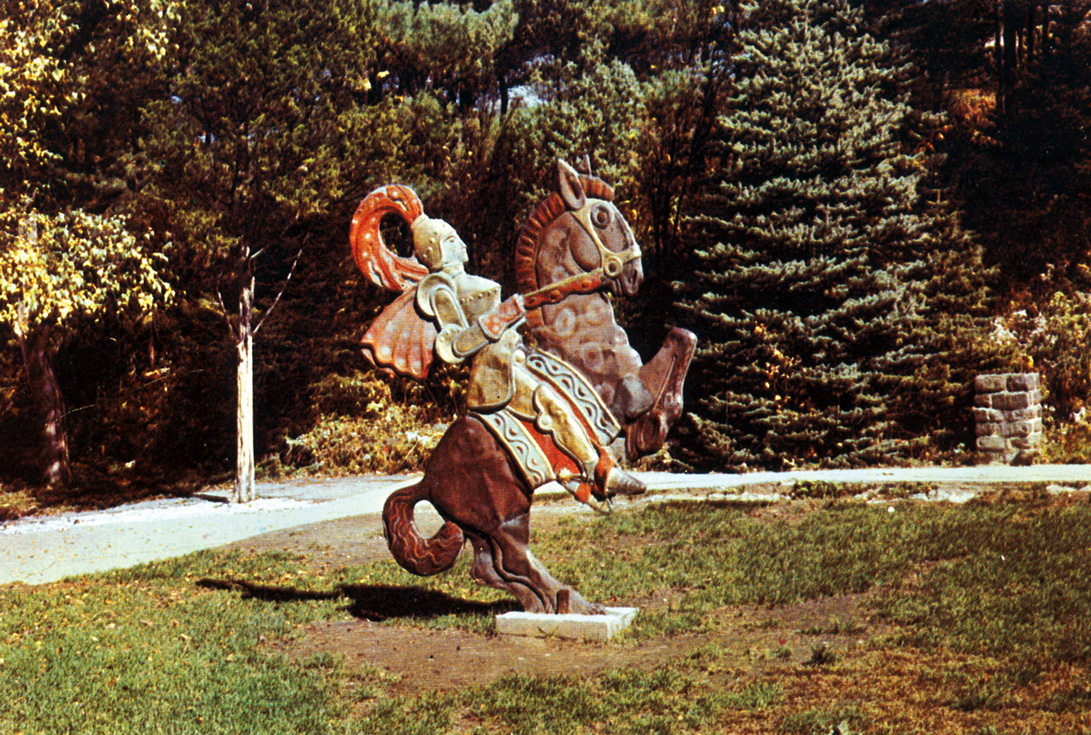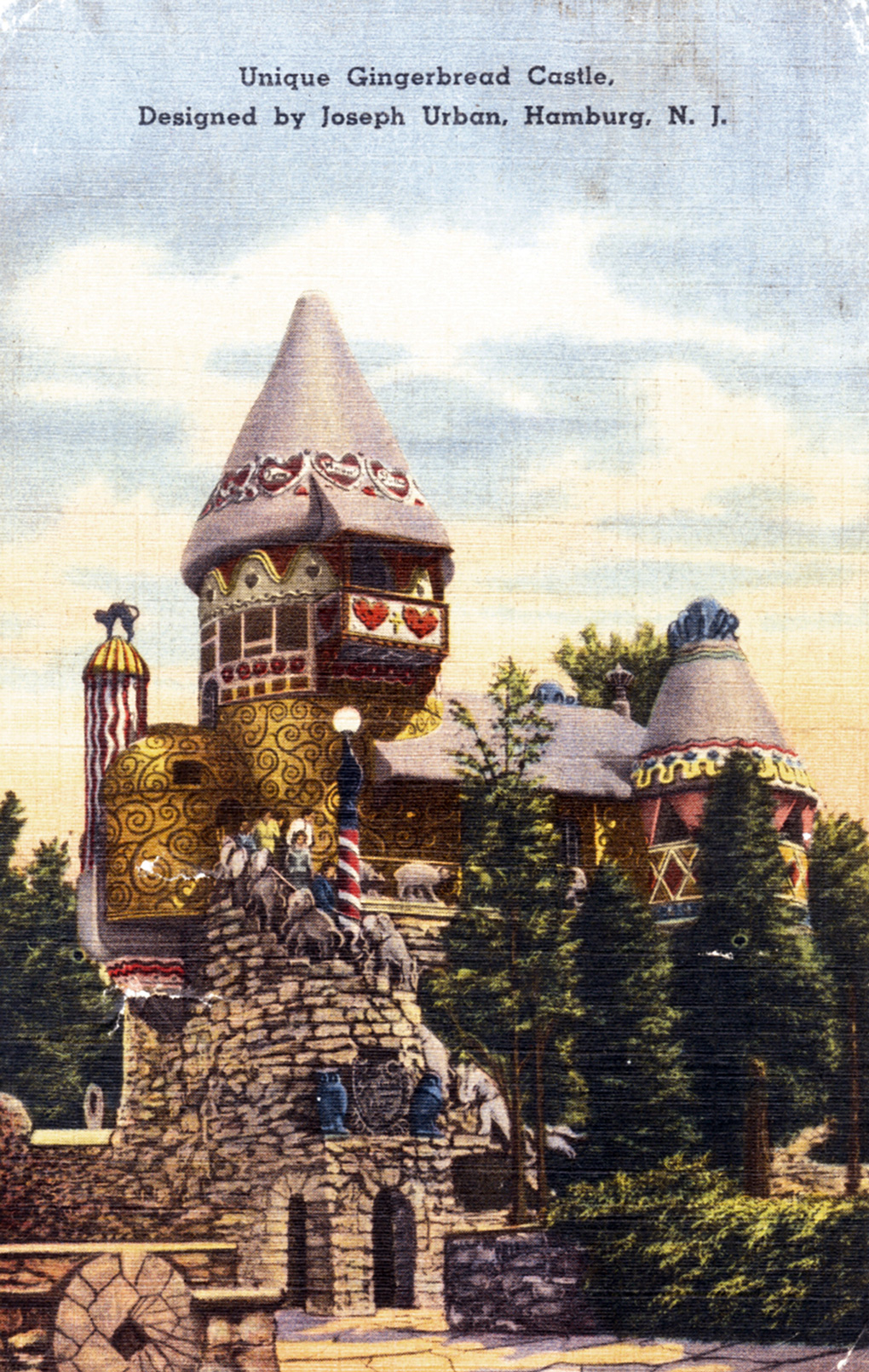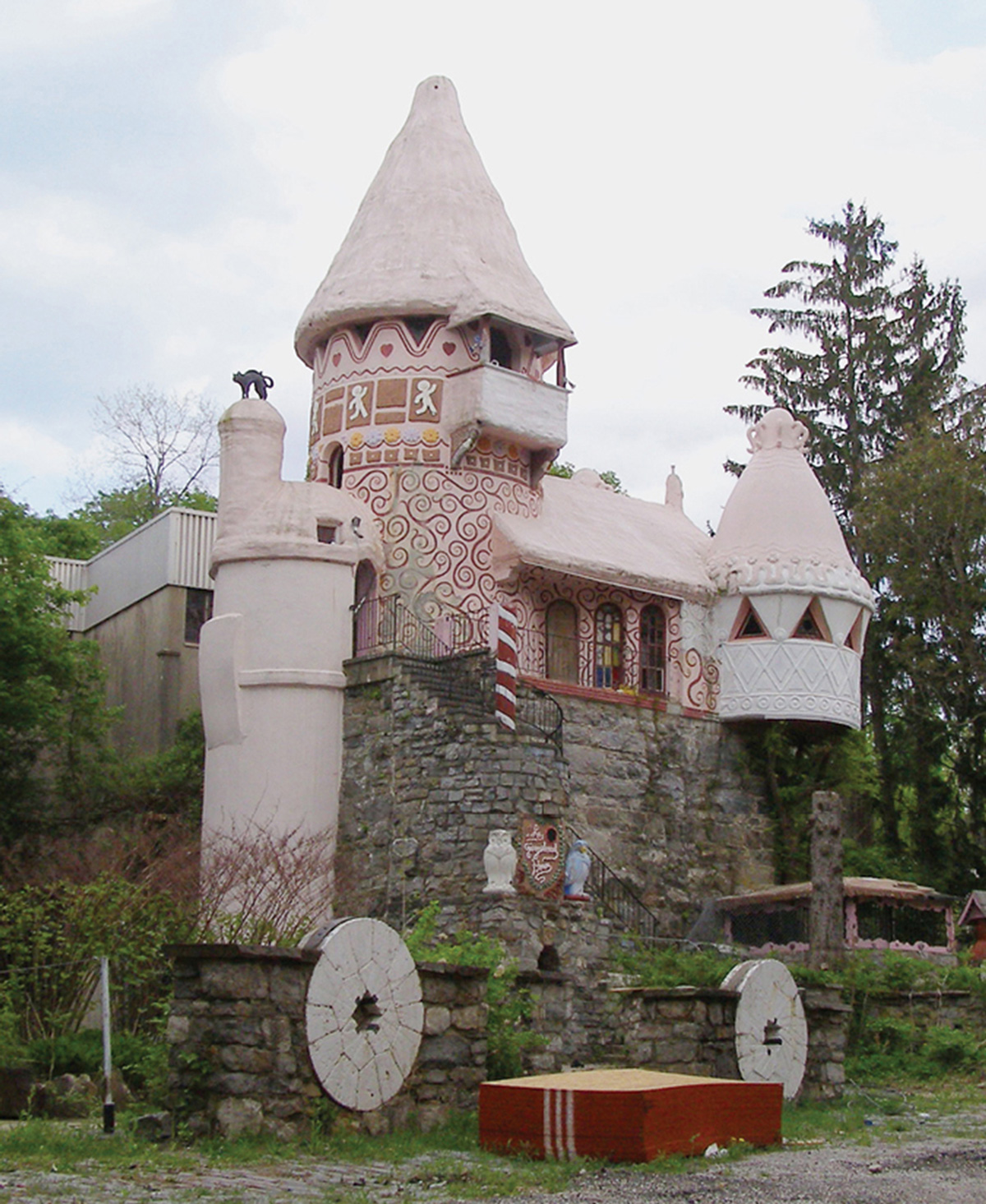Ingestion / Hexed House
Nibble, nibble
Mark Morris
“Ingestion” is a column that explores food within a framework informed by aesthetics, history, and philosophy.
For the children, the chef would always bake a large gingerbread castle, wonderfully decorated with scores of marzipan peasants and serfs scaling the walls and overthrowing the parasitical king and his family.
—James Finn Garner
Earlier this year a gingerbread castle was sold at a sheriff’s auction for $679,104.02. The castle, located in Hamburg, New Jersey, was purchased by a local real estate developer after the previous owner could no longer finance the 7.3-acre property. The place had once been a tourist attraction; more than a roadside curiosity, but never quite a full-fledged theme park. It is now in steep disrepair. A failed restaurant across the road from the gingerbread castle, the Castle Grille, also came with the purchase price.
This unusual structure, eighty years old, features a rusticated base, animal statuary, walls incised with decorative swirls and turrets seemingly iced with hearts, swags, and dimples of colored stucco. It may or may not be saved from demolition. Several owners have tried and failed to revive its fortunes since the late 1970s. What was popular during the Depression through the 1950s—the height of the roadside folly phenomenon—might not be enough of a draw today. However, it is one of a handful of remaining buildings designed by Joseph Urban (1872–1933), who also built the Ziegfeld Theatre, the New School for Social Research, the Hearst Tower, the Palm Beach Bath and Tennis Club, the William Penn Hotel in Pittsburgh, and Mar-A-Lago (the 62,000-square-foot house designed for Marjorie Merriweather Post and Edward F. Hutton, now owned by Donald Trump).

Also an accomplished set designer for several opera houses, not to mention the Ziegfeld Follies, Urban was commissioned to design Gingerbread Castle by Fred H. Bennett, the owner of a flour mill. In Willy Wonka-esque fashion, Bennett requested a structure, intended to delight children and adults alike, to be built near his Wheatsworth cracker factory. Time, covering the opening of the castle in 1930, described Urban as that “globular Viennese Architect and stage setter.” Bennett recounted that he had been inspired to build Gingerbread Castle after attending Engelbert Humperdinck’s opera Hansel and Gretel to take his mind off business problems:
My eye was taken by the quaint fantastic fairyland gingerbread house on the stage. The thought struck me, ‘just the thing!’ Something like that for the children on the old cement kiln across the courtyard from the mill. I went to see the decorator Joseph Urban who designs the stage settings for the Metropolitan Opera, and he’s been hard at work on this Gingerbread House of mine for two years. It cost $50,000, but if it brings the children and their mothers, it’s well worth it.

People who claim childhood memories of the Gingerbread Castle in its heyday have snuck beyond the “no trespassing” signs and blogged creepy photographs of it in ruins; creepy in the way the decay of edible, or seemingly edible, things always are. (Think of the repulsion conjured by Miss Havisham’s bridal cake in Great Expectations.) The castle was always intended to be eerie on the inside with carved fairies, gnomes, mechanical spiders, bones, and a strange tableau featuring a cauldron of stewing bodies (taken to be the giant’s handiwork from the story of Jack and the Beanstalk). There are also colored statues of children throughout and, of course, a witch, who used to fly on a broomstick along the ceiling. As in the Hansel and Gretel tale, the witch was even shoved into an oven at the culmination of the tour. Bennett naturally linked his flour-making business to the traditional gingerbread house, oddly one of those objects where its interest (something as solid as a house made digestible) is not satisfied by actually eating it.
Urban’s castle plays to the fantasy of imagining oneself, like Hansel or Gretel, eating a life-sized bit of architecture. The Grimm fairytale deals with hunger on many levels. Hansel and Gretel are so hungry they continue to eat the gingerbread house even after they hear the witch warbling, “Nibble nibble…” Their parents, recall, are so hungry they are willing to abandon their kids in a forest to save more food for themselves. The hungry birds eat Hansel’s breadcrumbs left on the path, making the children lose their way. Hansel is encaged and force-fed, and only gets freed after an underfed and overworked Gretel cooks the witch. In doing so, Gretel also liberates the other children who had been lured by the house and turned into gingerbread figures at the gateway. Putting the Castle Grille across the street was meant to tap into this suggestion of hunger, except that a hamburger may not be the thing to satisfy an appetite whetted by an illusion of gargantuan pastry.
The type of gingerbread used to mold little figures and houses is the most recent and cement-like of its variations. As its name implies, gingerbread was originally spiced bread or cake; a holiday indulgence when spices were luxury goods. Ginger, also used as a preservative, is only one of several spices, among them nutmeg, allspice, cinnamon, cloves, aniseed, and ground pepper, that one might include in a gingerbread recipe. Indeed, the French refer to gingerbread as pain d’épices, and their version is more like pastry. It is the Old French term for ginger itself, gingebras, that migrated to English as the word for the cake. Nuremberg’s honeyed Lebkuchen straddle the cake/cookie divide, and it is out of that fourteenth-century culinary tradition that denser dough arrives and forms horses, hearts, and finally, houses. Architecture mimicking gingerbread in a generic sense can be seen in certain late-nineteenth-century house designs noted for their fancy carpentry details, referred to as “Gingerbread.” More overt architectural references to gingerbread, as seen with Urban’s castle, are rare, but others do exist, such as Antoni Gaudí’s gatehouses to the Parc Güell in Barcelona.

The new owner of Gingerbread Castle is begging for the return of the many figures stolen from the property in recent years, including the witch and a clapping seal that used to balance atop a candy cane. To revive the castle, its old tenants must return. One wonders how far their diaspora extends, how many have made their way to eBay. Certain figures are more integral to the building than others, but it is the exterior’s shallow relief detail that ultimately makes up the castle’s distinctive decorative program, its scrumptious appeal.
The Simpsons Halloween send-up of Hansel and Gretel includes a scene in which Homer tries to rescue Bart and Lisa from a gingerbread house, but forgets his purpose once he decides to eat his way in:
Homer: Mmmm ... sugar walls.
Lisa: Father! I knew you’d rescue us!
Homer: Oh, rescue you, stuff myself with candy, it’s all good!
Witch: Oh, that’s a load-bearing candy cane! You clumsy oaf!
With Urban’s design, the “candy” really is load-bearing, but now starting to sag and crumble. In its declining years, even when it was no longer normally open, the castle was recast as a haunted house each October. The decay, fragmented narrative, sad history (including the lost fortunes of previous owners), and bizarre scale of the place all made for an unintentionally perfect haunted house; a witch’s house, which is what the Germans call a gingerbread house after all—hexenhaus. Hexed or not, New Jersey’s State Route 23 will not seem as sweet without it.
Mark Morris teaches design and theory at Cornell University’s College of Architecture, Art and Planning where he coordinates post-professional degree programs. He is author of Models: Architecture and the Miniature (Wiley, 2006) and host of the “Architecture on Air” podcast series. He is currently co-authoring a book on models as contemporary art with Kathy Battista.
Spotted an error? Email us at corrections at cabinetmagazine dot org.
If you’ve enjoyed the free articles that we offer on our site, please consider subscribing to our nonprofit magazine. You get twelve online issues and unlimited access to all our archives.